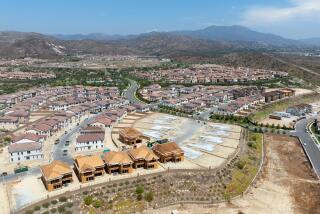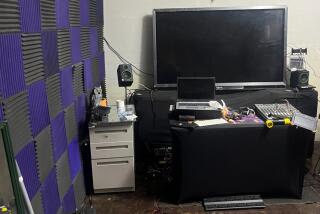FOCUS : Businesses and Marines: All in the Neighborhood
- Share via
In a real estate developer’s dream tract, the largest plot of land belongs to the U.S. Marines.
Near the northeastern corner of an area defined by the Santa Ana, San Diego and Costa Mesa freeways and Culver Drive in Irvine, the U.S. Marine Corps Helicopter Air Station in Tustin occupies 1,558 acres of prime commercial/industrial acreage. It borders the rich concentration of private industries in Irvine Business Complex, which boasts 47 Fortune 500 companies and nearly 600 corporate headquarters.
Surrounded by a granite-and-glass high-tech business community where “old” buildings are those built 15 years ago, the World War II military base shows its age. Its 1,088-foot-long hangars were constructed in 1941 to house submarine-hunting blimps for the U.S. Navy. The largest unsupported wooden structures in the world, the hangars earned the base a national landmark designation in 1978.
Today, the air station’s 140 helicopters are used for troop training and to transport troops and cargo in the Western Pacific. With 4,030 military and civilian employees, the Tustin station is the county’s second largest employer (after Hughes Aircraft Co.) and pumps half a billion dollars into the local economy.
More than 4,600 people live on the base--currently the only residents in the air station-Irvine Business Complex neighborhood. That’s changing, however, as the Marines plan more housing units on the base and the city of Irvine departs from master-plan tenets that historically proscribed mixing housing and high-rises.
At Jamboree Road and Kelvin Avenue, the Charter Apartments, first residential development in the business complex, is nearing completion. And more homes are on the drawing boards as the developers and the city of Irvine explore ways to integrate working and living areas.
Land between the marine base and the San Diego Freeway was formerly inexpensive industrial space, but much of it now is used for executive office parks, research and development and some retail. While industrial and R&D; space is expected to remain stable, projections indicate office space will more than double by 1995.
High-rise office space and large mixed-use projects such as Koll Center Irvine now dominate development along the San Diego Freeway. And restaurants, hotels, upscale athletic clubs, theaters and shops abound in the emerging urban village.
More to Read
Inside the business of entertainment
The Wide Shot brings you news, analysis and insights on everything from streaming wars to production — and what it all means for the future.
You may occasionally receive promotional content from the Los Angeles Times.










